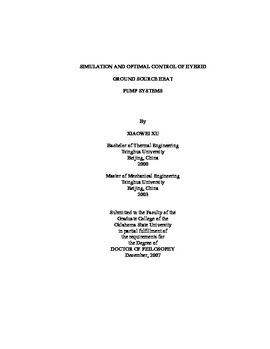| dc.contributor.advisor | Spitler, Jeffrey D. | |
| dc.contributor.author | Xu, Xiaowei | |
| dc.date.accessioned | 2013-12-10T18:05:23Z | |
| dc.date.available | 2013-12-10T18:05:23Z | |
| dc.date.issued | 2007-12 | |
| dc.identifier.uri | https://hdl.handle.net/11244/7824 | |
| dc.description.abstract | Scope and Method of Study: The objective of the study was development of optimal control strategies for hybrid ground-source heat pump (HGSHP) systems in order to improve the performance of HGSHP systems. The investigations of the four sub-objectives were carried out, including: development of HGSHP system simulation and requisite component models, validation of HGSHP system and component simulation, development of an HGSHP system design procedure, investigation and development of generally applicable optimal control strategies. | |
| dc.description.abstract | Findings and Conclusions: All requisite component models for the HGSHP system simulation have been developed. The HGSHP system simulation has been implemented in HVACSIM+. The HGSHP system simulation was validated against the experimental data collected from the OSU HGSHP research facility. After the calibration of each component model, the simulation gave total energy consumption about 0.2% higher than the experiment. | |
| dc.description.abstract | A parallel-connected HGSHP system was chosen for the study and a strategy for controlling the flow distribution between GLHE and PHE/cooling tower was developed. A temperature limit-optimized simulation-based method was developed for sizing the HGSHP system components and was implemented in GLHEPRO. A comparative study of three hybrid ground source heat pump system design procedures was carried out. In general, the HGSHP designed from the new design procedure would have a smaller GLHE and cooling tower size and a smaller system life cycle cost than the system designed from the Kavanaugh and Rafferty procedure (1997). | |
| dc.description.abstract | Two building types and six U.S. cities were chosen to provide different building load profile for the study of HGSHP system controls. Three control strategies developed by Yavuzturk and Spitler (2000) were investigated first. The investigation results showed, for the three control strategies, there is no generally-applicable setpoint for different combinations of HGSHP system design, building type and location. Three new control strategies have been developed in this research: a system load control strategy, a forecast/historical control strategy and a varied EFT/ExFT control strategy. Using these new control strategies, without individually optimizing setpoint for a specific building and location combination, the systems will have savings from 1% to 26% compared to the base cases. | |
| dc.format | application/pdf | |
| dc.language | en_US | |
| dc.rights | Copyright is held by the author who has granted the Oklahoma State University Library the non-exclusive right to share this material in its institutional repository. Contact Digital Library Services at lib-dls@okstate.edu or 405-744-9161 for the permission policy on the use, reproduction or distribution of this material. | |
| dc.title | Simulation and optimal control of hybrid ground source heat pump systems | |
| dc.contributor.committeeMember | Fisher, Daniel E. | |
| dc.contributor.committeeMember | Cremaschi, Lorenzo | |
| dc.contributor.committeeMember | Bose, James | |
| osu.filename | Xu_okstate_0664D_2523.pdf | |
| osu.accesstype | Open Access | |
| dc.type.genre | Dissertation | |
| dc.type.material | Text | |
| thesis.degree.discipline | Mechanical Engineering | |
| thesis.degree.grantor | Oklahoma State University | |
